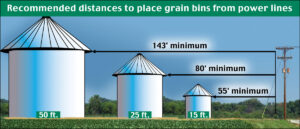 Electrical power is an indispensable part of modern agricultural operations. In fact, electricity is such a commonplace part of a farm operation that it can all too easily become a part of the scenery and its hazards overlooked. One often overlooked safety consideration is the power line clearance required for grain bins. Safe Electricity provides tips on avoiding electrical hazards around the farm, including the construction of grain bins.
Electrical power is an indispensable part of modern agricultural operations. In fact, electricity is such a commonplace part of a farm operation that it can all too easily become a part of the scenery and its hazards overlooked. One often overlooked safety consideration is the power line clearance required for grain bins. Safe Electricity provides tips on avoiding electrical hazards around the farm, including the construction of grain bins.
“Electrical hazards include large equipment and farm structures near overhead power lines,” says Richard McCracken, Safe Electricity Advisory Board member. “The best way to avoid problems is to keep equipment and new construction a safe distance from power lines.”
Equipment and vehicles, such as augers and grain trucks, around grain bins are particularly at risk of coming into contact with overhead power lines. It is important that bins be built a safe distance from power lines to help ensure the safety all farm workers.
 The National Electric Safety Code sets minimum clearances around grain bins. It requires that any high-voltage power lines (over 600 volts) be at least 18 feet above the highest point on a grain bin. Additionally, the Code sets the minimum distance that power lines must be from grain bins, depending on the bin’s height. For instance, a bin that is 15-feet tall must be at least 55 feet from power lines on its loading side, and a bin that is 50-feet in height must be at least 143 feet from power lines on its loading side.
The National Electric Safety Code sets minimum clearances around grain bins. It requires that any high-voltage power lines (over 600 volts) be at least 18 feet above the highest point on a grain bin. Additionally, the Code sets the minimum distance that power lines must be from grain bins, depending on the bin’s height. For instance, a bin that is 15-feet tall must be at least 55 feet from power lines on its loading side, and a bin that is 50-feet in height must be at least 143 feet from power lines on its loading side.
Your state and utility may have additional requirements. If planning on constructing a new grain bin, contact your local utility before any construction begins. They can help you determine minimum safety requirements.
Keep these additional safety tips in mind anytime you are operating large farm equipment around power lines:
• Keep equipment at least 10 feet from lines—at all times, in all directions.
• Inspect the height of the farm equipment to determine clearance.
• Always remember to lower extensions when moving loads.
• Use a spotter when operating large machinery near lines.
• Never attempt to move a power line out of the way or raise it for clearance.
• If a power line is sagging or low, contact your local utility.

If equipment does come into contact with a power line, remember, stay on the equipment until the utility has arrived to de-energize the lines. Warn others to stay away, and call the local utility provider immediately. The only reason to exit is if the equipment is on fire. If this is the case, jump off the equipment with your feet together and without touching the ground and vehicle at the same time. Then, still keeping your feet together, “bunny hop” away to safety.
For more electrical safety information, visit SafeElectricity.org.









